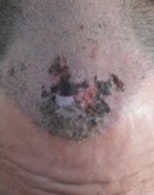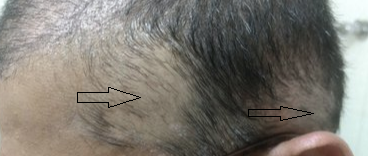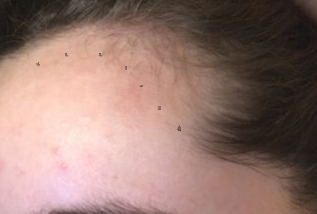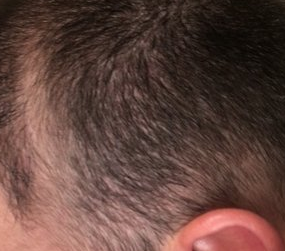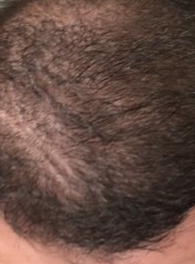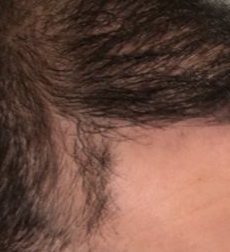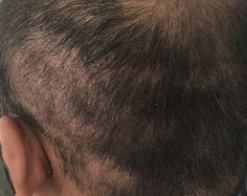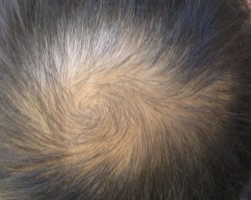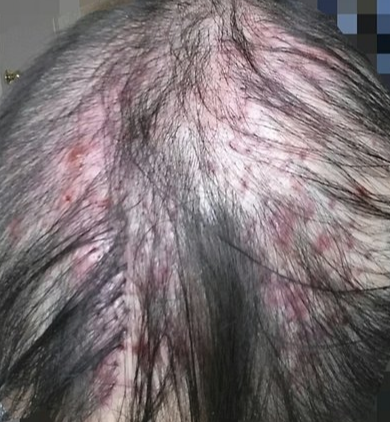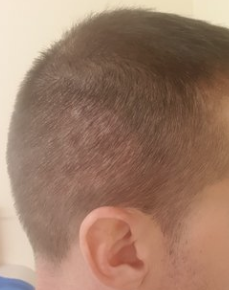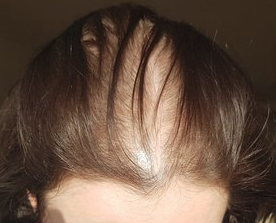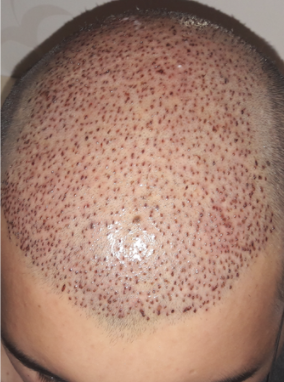I belieeve that you are addressing the hair loss on the sides and in the back that are shown in the photo shown by the arrows. I have never seen this type of loss outside of the transplanted area and in areas (particularly the side) where the hair is usually permanent. Time will tell (6 months) if this is the result of the anesthetic or not. .A biopsy, at some point in time, may be a reasonable thing to do by a good dermatologist? who should be managing the problem
The recipient are requires daily washes as well to keep the recipient area free of crusts. I generally recommend the use of a sponge and supply my patient with a surgical sponge to fill with soapy water and press on the recipient area daily. By repeating this daily, all crusts can be washed off without any fear of losing grafts and you should be clean of crusts within a day. IF any crust are present, use a Q tip and dip it into soapy water, and roll it on the crusts and that will lift them off without dislodging them, but never rub them, just roll the Q tip on the recipient crust. I like to see no evidence of any crusting in the recipient area and the crusts from the donor area gone in 7-10 days with daily washing, You will have to leave the shampoo on for a good 15 minutes and gently rub the crusts with your fingers. Be sure not to pull them off, just let them shed with the shampoo and it will take a few days for this to happen. You can wash twice a day if you wish to accelerate the process.
I already had hair on my scalp, I wasn’t totally bald. The doctor in a very cheap clinic in Istanbul said they will try to fill the spaces with 2500 grafts. I can’t tell if what I had done worked. I think he was not honest, How do I find out if he really gave me 2500 grafts at the time of the surgery?
To find out how many grafts, you should ask your doctor for a copy of the surgical record which will have the number of grafts and the number of hairs that were in each graft. If you do not trust your surgeon that is another matter. Bonding with your surgeon is critical BEFORE the transplant gets done. Your lack of trust makes this a foregone conclusion regardless of what the records show you.
You have not only a high hairline which seems to be your primary concern, but your temple promenances are eroded. If you want to address the temple areas as well as the hairline position, then a hair transplant lowing is a better procedure as shown with the dots that outline where a hairline lowering procedure can not address. Here is an example of such a patient: https://baldingblog.com/wp-admin/post.php?post=22445&action=edit
There are many comments I could make here. There are teams of technicians working on a case of your size and if any of them had less skills than others, the grafts placed by the less skilled technicians could have caused this problem. There are many technical nuances in a hair transplant and any of them could have caused this problem, so speaking with your doctor is a good idea, at the least to get the feedback you need.
It appears that all of the native hair was lost from the surgery (before photo on the left and after on the right)and that your hair transplant was a failure. I always tell my patients that to hold on to their native hair, then should go on the drug finasteride, Go back and meet with your surgeon? and your surgeon should make it right for you.
I would like the bald crown filled in as much as possible without that large ugly scar from the old methods of hair transplantation. Is the FUE and ARTAS are reasonable option? I only want the best!
Any hair transplant will fill in the crown. There are stip procedures and there are FUE procedures which are manual or robotic. You should shop this around and then make the decision yourself. Find a doctor you like with a great reputation and years of experience in the field, a doctor respected by other doctors. In the hands of a good doctor, any of these procedures is a good procedure. Your hair loss looks like mine did before I had strip procedure and now I don’t have a bald crown nor any scar as a result of thes trip procedures?
A year ago, I got my synthetic hair implant in another country clinic, since they really persuaded me to try out their biofiber synthetic hair implant made from Italy. Now I started having inflammation and redness and itching, I visited a dermatologists who recommended that I get these removed immediately.
I have seen such patients and their entire scalp becomes very infected and scarred, even after the removal of the synthetic implants. This takes a long time and many visits as some of the implants get burried in the scalp. Fortunately, these have been outlawed in the US and many countries, but a few clinics remain in Europe and elsewhere offering it and some people think it is a great idea and may pay heavily for the decision to get them.
My hair is thin everywhere, front, top, crown, and the sides of the hair. Each doctor I met with gave me a different number for transplants, but isn’t it of a concern with such much thinning all over my head.
Yes, what you are descriging is diffuse hair loss. This is common as a genetic trait in some women and they may see it in their mothers, sistgers, aunts. When this is the case, this is not a transplant situation, Diffuse unpatterned hair loss, typical for many women with genetic hair loss, should never be transplanted. I suspect that the doctors are looking at you as a source of paying off their mortgage. We would perform Scalp Micropigmentation on your scalp, which is a cosmetic unique stippled tattoo and will change the color of the scalp and make the thinning almost disappear. This is not hair, but a highly specialized tattoo, see here for many good examples: https://scalpmicropigmentation.com/smp-for-women/
To find out how many grafts, you should ask your doctor for a copy of the surgical record which will have the number of grafts and the number of hairs that were in each graft. If you do not trust your surgeon that is another matter. Bonding with your surgeon is critical BEFORE the transplant gets done. Your lack of trust makes this a foregone conclusion.

